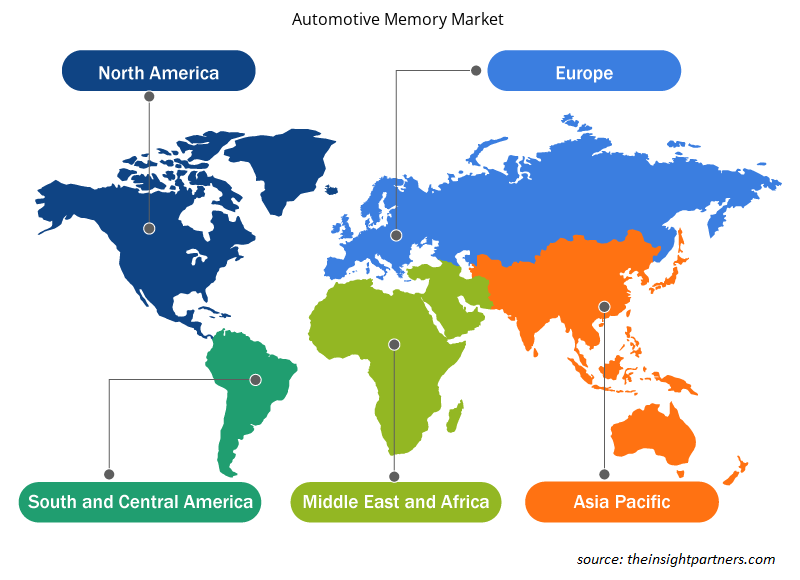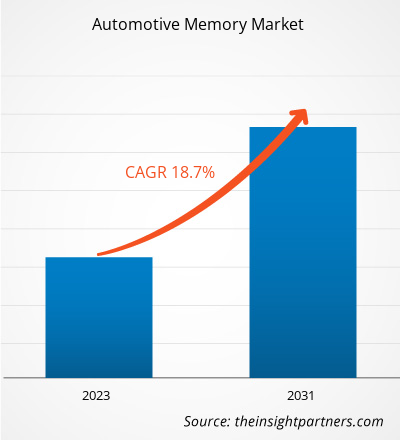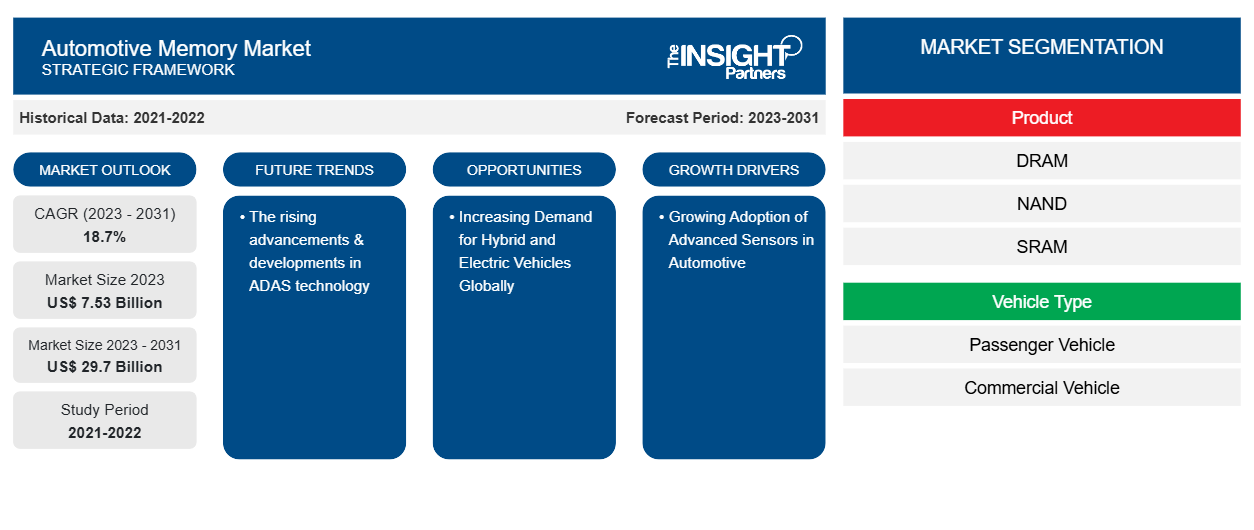Der Markt für Automotive-Speicher wird voraussichtlich von 7,53 Milliarden US-Dollar im Jahr 2023 auf 29,7 Milliarden US-Dollar im Jahr 2031 anwachsen. Der Markt wird zwischen 2023 und 2031 voraussichtlich eine durchschnittliche jährliche Wachstumsrate (CAGR) von 18,7 % verzeichnen. Die zunehmenden Fortschritte und Entwicklungen in der ADAS-Technologie werden voraussichtlich weiterhin wichtige Trends auf dem Markt bleiben.
Automotive-Speicher-Marktanalyse
Die steigende Nachfrage nach Automobiltelematik und der Einsatz von Sensoren in Automobilanwendungen dürften die Nachfrage nach Automobilspeichern ankurbeln, was wiederum das Marktwachstum in den kommenden Jahren ankurbeln dürfte. Darüber hinaus dürften strenge staatliche Normen für den Einsatz von Telematik in Fahrzeugen das Marktwachstum von 2023 bis 2031 ankurbeln. Darüber hinaus dürfte die weltweit steigende Nachfrage nach Hybridelektrofahrzeugen und Elektrofahrzeugen die Nachfrage nach Automobilspeichern ankurbeln, was wiederum im Prognosezeitraum Chancen für die wichtigsten Unternehmen auf dem Markt schaffen dürfte.
Marktübersicht für Automotive-Speicher
Fahrzeuge sind derzeit mit einer Vielzahl von verteilten Speichertypen ausgestattet, wie z. B. statischer Direktzugriffsspeicher, dynamischer Direktzugriffsspeicher, Nur-Lese-Speicher , FLASH und in einigen Fällen magnetoresistiver Direktzugriffsspeicher (MRAM). Testen. Automobilspeicher ähneln in ihrer Funktion kommerziellen Speichern, funktionieren jedoch anders. Sie ähneln eher ECC-Speichern (Error Correcting Code), die auf dem Ergebnis des Speicherzugriffs basieren und die gespeicherten Informationen korrekt sind. Da immer mehr Mikroprozessoren verwendet werden, wird verteilter DRAM verwendet, der lokal für die Signal- und Informationsverarbeitung sowie SRAM- oder FLASH-Speicher verantwortlich ist, um Informationen zwischen Funktionen im Fahrzeug zu übertragen.
Die neue Automobilarchitektur umfasst eine zentralisierte primäre Zentraleinheit (CPU) mit einem riesigen Speicherarray, vergleichbar mit dem eines normalen Computers. Basierend auf den Daten aller Fahrerassistenz-, Motor- und Antriebssubsysteme verarbeitet diese Einheit systemische Entscheidungen und trifft diese. Im Gegensatz zu Heim- und Geschäftscomputern, die eine Lebensdauer von 2 bis 5 Jahren haben, muss der Autospeicher 12 bis 20 Jahre lang kontinuierlich laufen.
Passen Sie diesen Bericht Ihren Anforderungen an
Sie erhalten kostenlos individuelle Anpassungen an jedem Bericht, einschließlich Teilen dieses Berichts oder einer Analyse auf Länderebene, eines Excel-Datenpakets sowie tolle Angebote und Rabatte für Start-ups und Universitäten.
-
Holen Sie sich die wichtigsten Markttrends aus diesem Bericht.Dieses KOSTENLOSE Beispiel umfasst eine Datenanalyse von Markttrends bis hin zu Schätzungen und Prognosen.
Treiber und Chancen auf dem Automotive-Speichermarkt
Zunehmender Einsatz moderner Sensoren im Automobilbereich begünstigt den Markt
Automobilsensoren sind für den reibungslosen Betrieb moderner Autos unerlässlich. Diese Sensoren liefern der elektronischen Steuereinheit (ECU) Informationen über zahlreiche Fahrzeugparameter und maximieren so Sicherheit, Effizienz und Leistung. Dies tun sie, indem sie physikalische Größen in elektrische Impulse umwandeln. Diese Sensoren werden in zwei Hauptkategorien eingeteilt: erstens nach den physikalischen Eigenschaften, die sie messen, und zweitens nach der zugrunde liegenden Technologie, die sie verwenden. Die Sensoren helfen, Fehler durch Verschleiß oder Verschmutzung zu reduzieren, gewährleisten stabile Messungen und sparen Platz in Hochtemperaturumgebungen. Die Nachfrage nach Drucksensoren wird voraussichtlich stark ansteigen und die Branche schnell vorantreiben. In den Seitentüren des Autos sind Drucksensoren eingebaut, die digitale Crash-Signale an die zentrale Airbag-Einheit senden, um Unfälle zu verhindern. Daher wird erwartet, dass der zunehmende Einsatz fortschrittlicher Sensoren in Automobilanwendungen das Marktwachstum in den kommenden Jahren vorantreiben wird.
Steigende Nachfrage nach Hybrid- und Elektrofahrzeugen weltweit
Der Anstieg vollelektrischer Fahrzeuge (EV) und Hybridelektrofahrzeuge, begleitet von der Einführung von ADAS, grafischen Instrumentenclustern (GIC), Infotainmentsystemen und Lösungen für vollautonomes Fahren, führte zu einer Nachfrage nach elektronischen Steuergeräten (ECU) – Fahrzeugsteuergeräten, die Signale von Sensoren empfangen und verarbeiten und Steuerbefehle an den Aktuator zur Ausführung übermitteln. So wurden in den USA im Jahr 2023 insgesamt rund 1.400.000 neue Elektroautos zugelassen, was einem Anstieg von 40 % gegenüber 2022 entspricht. Ein solcher Anstieg der Nachfrage nach Elektrofahrzeugen dürfte eine Chance für die wichtigsten Akteure auf dem Automobilspeichermarkt schaffen.
Segmentierungsanalyse des Automotive-Speichermarktberichts
Wichtige Segmente, die zur Ableitung der Marktanalyse für Automobilspeicher beigetragen haben, sind Produkt, Fahrzeugtyp und Anwendung.
- Basierend auf dem Produkt ist der Automobilspeichermarkt in DRAM, NAND, SRAM, NOR und andere unterteilt. Das DRAM-Segment hatte im Jahr 2023 den größten Marktanteil.
- Nach Fahrzeugtyp ist der Markt in Personenkraftwagen und Nutzfahrzeuge segmentiert. Das Personenkraftwagensegment hatte im Jahr 2023 den größten Marktanteil.
- Nach Anwendung wird der Markt in Infotainment & Konnektivität, ADAS und Sonstiges unterteilt. Das Segment Sonstige hielt im Jahr 2023 einen erheblichen Marktanteil.
Marktanteilsanalyse für Automobilspeicher nach Geografie
Der geografische Umfang des Marktberichts für Automobilspeicher ist hauptsächlich in fünf Regionen unterteilt: Nordamerika, Asien-Pazifik, Europa, Naher Osten und Afrika sowie Süd- und Mittelamerika.
Der Umfang des Berichts zum Automobilspeichermarkt umfasst Nordamerika (USA, Kanada und Mexiko), Europa (Spanien, Großbritannien, Deutschland, Frankreich, Italien und den Rest Europas), den asiatisch-pazifischen Raum (Südkorea, China, Indien, Japan, Australien und den Rest des asiatisch-pazifischen Raums), den Nahen Osten und Afrika (Südafrika, Saudi-Arabien, die Vereinigten Arabischen Emirate und den Rest des Nahen Ostens und Afrikas) sowie Südamerika (Brasilien, Argentinien und den Rest Südamerikas). In Bezug auf den Umsatz dominierte der asiatisch-pazifische Raum im Jahr 2023 den Marktanteil des Automobilspeichers. Nordamerika ist der zweitgrößte Beitragszahler zum globalen Automobilspeichermarkt, gefolgt von Europa.
Regionale Einblicke in den Automobilspeichermarkt
Die regionalen Trends und Faktoren, die den Automotive-Speichermarkt während des Prognosezeitraums beeinflussen, wurden von den Analysten von Insight Partners ausführlich erläutert. In diesem Abschnitt werden auch die Segmente und Geografien des Automotive-Speichermarkts in Nordamerika, Europa, im asiatisch-pazifischen Raum, im Nahen Osten und Afrika sowie in Süd- und Mittelamerika erörtert.

- Erhalten Sie regionale Daten zum Automotive-Speichermarkt
Umfang des Marktberichts zu Speichermedien für Kraftfahrzeuge
| Berichtsattribut | Details |
|---|---|
| Marktgröße im Jahr 2023 | 7,53 Milliarden US-Dollar |
| Marktgröße bis 2031 | 29,7 Milliarden US-Dollar |
| Globale CAGR (2023 - 2031) | 18,7 % |
| Historische Daten | 2021-2022 |
| Prognosezeitraum | 2023–2031 |
| Abgedeckte Segmente |
Nach Produkt
|
| Abgedeckte Regionen und Länder |
Nordamerika
|
| Marktführer und wichtige Unternehmensprofile |
|
Marktdichte von Speichersystemen für Kraftfahrzeuge: Auswirkungen auf die Geschäftsdynamik verstehen
Der Automotive Memory-Markt wächst rasant, angetrieben durch die steigende Endverbrauchernachfrage aufgrund von Faktoren wie sich entwickelnden Verbraucherpräferenzen, technologischen Fortschritten und einem größeren Bewusstsein für die Vorteile des Produkts. Mit steigender Nachfrage erweitern Unternehmen ihr Angebot, entwickeln Innovationen, um die Bedürfnisse der Verbraucher zu erfüllen, und nutzen neue Trends, was das Marktwachstum weiter ankurbelt.
Die Marktteilnehmerdichte bezieht sich auf die Verteilung der Firmen oder Unternehmen, die in einem bestimmten Markt oder einer bestimmten Branche tätig sind. Sie gibt an, wie viele Wettbewerber (Marktteilnehmer) in einem bestimmten Marktraum im Verhältnis zu seiner Größe oder seinem gesamten Marktwert präsent sind.
Die wichtigsten auf dem Automobilspeichermarkt tätigen Unternehmen sind:
- Micron Technology Inc.
- Samsung Electronics Co., Ltd.
- Toshiba Corporation
- Western Digital Technologies, Inc.
- SK Hynix
- Macronix International Co.
Haftungsausschluss : Die oben aufgeführten Unternehmen sind nicht in einer bestimmten Reihenfolge aufgeführt.

- Überblick über die wichtigsten Akteure auf dem Automotive-Speichermarkt
Neuigkeiten und aktuelle Entwicklungen zum Automotive-Speichermarkt
Der Automobilspeichermarkt wird durch die Erfassung qualitativer und quantitativer Daten nach Primär- und Sekundärforschung bewertet, die wichtige Unternehmensveröffentlichungen, Verbandsdaten und Datenbanken umfasst. Nachfolgend sind einige der Entwicklungen auf dem Automobilspeichermarkt aufgeführt:
- Samsung Electronics Co., Ltd. hat eine Vereinbarung mit SemiDrive unterzeichnet. Im Rahmen dieser Vereinbarung wird Samsung Electronics Co., Ltd. Automotive-Speicherlösungen für SemiDrive liefern. (Quelle: Samsung Electronics Co., Ltd., Pressemitteilung, August 2023)
- Samsung Electronics Co., Ltd. hat einen neuen GDDR7 32 Gbps DRAM entwickelt. Dieses neue Automotive-Speicherprodukt wird die Möglichkeiten in Anwendungen für KI, HPC und Automobile erweitern. (Quelle: Club Car, Pressemitteilung, März 2023)
Marktbericht zu Speichersystemen für Kraftfahrzeuge – Abdeckung und Ergebnisse
Der Bericht „Marktgröße und Prognose für Automobilspeicher (2021–2031)“ bietet eine detaillierte Analyse des Marktes, die die folgenden Bereiche abdeckt:
- Automotive-Speicher-Marktgröße und Prognose auf globaler, regionaler und Länderebene für alle wichtigen Marktsegmente, die im Rahmen des Berichts abgedeckt sind
- Trends im Automotive-Speichermarkt sowie Marktdynamik wie Treiber, Einschränkungen und wichtige Chancen
- Detaillierte PEST- und SWOT-Analyse
- Analyse des Automotive-Speichermarkts mit Blick auf wichtige Markttrends, globale und regionale Rahmenbedingungen, wichtige Akteure, Vorschriften und aktuelle Marktentwicklungen
- Branchenlandschaft und Wettbewerbsanalyse, einschließlich Marktkonzentration, Heatmap-Analyse, prominenten Akteuren und aktuellen Entwicklungen für den Automotive-Speichermarkt
- Detaillierte Firmenprofile
- Historische Analyse (2 Jahre), Basisjahr, Prognose (7 Jahre) mit CAGR
- PEST- und SWOT-Analyse
- Marktgröße Wert/Volumen – Global, Regional, Land
- Branchen- und Wettbewerbslandschaft
- Excel-Datensatz
Aktuelle Berichte
Erfahrungsberichte
Grund zum Kauf
- Fundierte Entscheidungsfindung
- Marktdynamik verstehen
- Wettbewerbsanalyse
- Kundeneinblicke
- Marktprognosen
- Risikominimierung
- Strategische Planung
- Investitionsbegründung
- Identifizierung neuer Märkte
- Verbesserung von Marketingstrategien
- Steigerung der Betriebseffizienz
- Anpassung an regulatorische Trends























 Kostenlose Probe anfordern für - Markt für Automobilspeicher
Kostenlose Probe anfordern für - Markt für Automobilspeicher